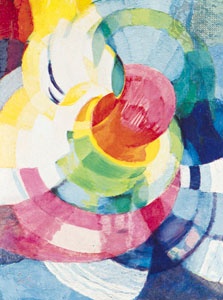Orphism
art movement
 in the visual arts, an artistic trend derived from Cubist (Cubism) painting that gave priority to colour. The movement was named in 1912 by the French poet Guillaume Apollinaire (Apollinaire, Guillaume).
in the visual arts, an artistic trend derived from Cubist (Cubism) painting that gave priority to colour. The movement was named in 1912 by the French poet Guillaume Apollinaire (Apollinaire, Guillaume).Apollinaire regarded the colourful Cubist-inspired paintings of Robert Delaunay (Delaunay, Robert) as initiating a new style that brought musical qualities to painting. He named this style Orphism in reference to Orpheus, the legendary poet and singer of ancient Greek mythology, who was a popular symbol of the ideal, mystically inspired artist. Other painters working in this style included Fernand Léger (Léger, Fernand), Francis Picabia (Picabia, Francis), and Marcel Duchamp.
The correlation between colour and music was an idea that interested many artists at the time. Symbolist (Symbolist movement) artists and writers saw analogies between musical tones and visual hues. The painter Wassily Kandinsky (Kandinsky, Wassily) had begun to associate music with the abstract aspects of his art, and he discussed the connections in his book Über das Geistige in der Kunst (1912; Concerning the Spiritual in Art).
Robert Delaunay was interested in the geometric fragmentation of Cubism, but—unlike the Cubist painters, who removed almost all colour from their paintings—he considered colour to be a powerful aesthetic element. One of the resources Delaunay used to discover how to integrate colour and Cubism was De la loi du contraste simultané des couleurs (1839; The Principles of Harmony and Contrast of Colours and Their Applications to the Arts) by the chemist Michel-Eugène Chevreul (Chevreul, Michel-Eugène). The Neo-Impressionist (Neo-Impressionism) painter Georges Seurat (Seurat, Georges) had employed these theories in figurative and landscape compositions during the 1880s, but Delaunay was interested in applying them in an abstract way, exploring the effects of colour and light when they are not bound to an object. In his painting Simultaneous Composition: Sun Disks (1912–13), for example, he painted superimposed circles of colour that have a sense of rhythm and movement that can be considered analogous to music harmony. His wife, Sonia Delaunay (Delaunay, Sonia), also experimented with an Orphic painting style.
Another painter associated with Orphism was František Kupka (Kupka, František), a Czech who lived in Paris. Kupka exhibited his abstract painting Disks of Newton (Study for Fugue in Two Colours) in 1912. As the musical analogy implicit in the title suggests, the vibrating colour orchestrations on the canvas were intended to unite visual and musical ideas.
Delaunay's canvases deeply impressed the artists August Macke (Macke, August), Franz Marc (Marc, Franz), and Paul Klee (Klee, Paul), who visited his Paris studio in 1912; this exposure had a decisive influence on their subsequent work. Orphism also influenced the development of Cubism in Germany.
Additional Reading
Studies of Orphism include Virginia Spate, Orphism: The Evolution of Non-Figurative Painting in Paris, 1910–1914 (1979); Hajo Düchting, Robert and Sonia Delaunay: The Triumph of Color (1994); and Adrian Hicken, Apollinaire, Cubism and Orphism (2002).
- Community of Christ
- community property
- commutation
- commutative law
- Commynes, Philippe de
- Comnenus family
- Como
- Comodoro Rivadavia
- Como, Lake
- Comorin, Cape
- Comoros
- Comoros, flag of
- compact bone
- compact disc
- compactness
- Compact of Warsaw
- Compagnia degli Accesi
- Compagnia degli Uniti
- Compagnia dei Desiosi
- Compagnia dei Fedeli
- Compagnia dei Gelosi
- Compagni, Dino
- Compagnie de Saint-Gobain-Pont-à-Mousson
- Compagnie Française des Indes
- Compagnie Française des Indes Orientales